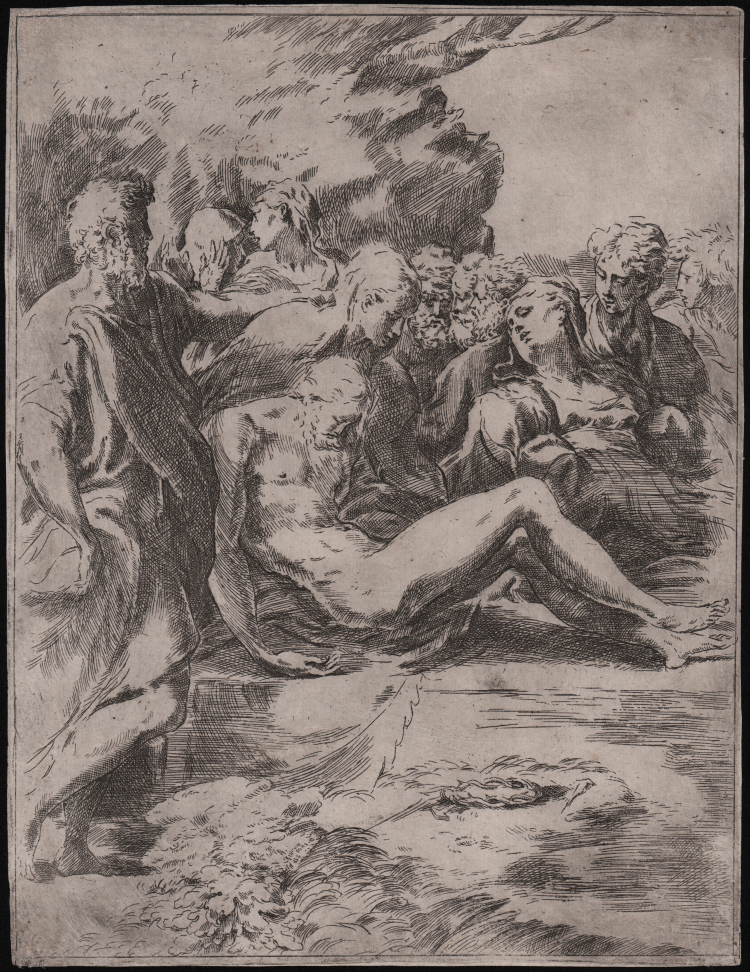



| Reference: | S40827 |
| Author | Guido RENI |
| Year: | 1595 ca. |
| Measures: | 207 x 270 mm |


| Reference: | S40827 |
| Author | Guido RENI |
| Year: | 1595 ca. |
| Measures: | 207 x 270 mm |
Etching and drypoint, 1595 circa. After Parmigianino. First state, of two, before the inscription and the address by Antonio Maria Magnani.
Good example printed on contemporary laid and watermarked paper, trimmed close to platemark, occasional foxing otherwise in very good condition.
This copy after Parmingianino engraved by Guido Reni was not mentioned by Bartsch.
“Giorgio Vasari was not exaggerating when he stated that Parmigianino "was liberally endowed with the richest gifts of a painter." Although his life was brief, Parmigianino was re- markably influential, inventive, and prolific, producing dozens of paintings and frescoes and hundreds of drawings. He must have been intrigued with prints, because he engaged with Jacopo Caraglio and Ugo da Carpi soon after moving to Rome in 1524, and he began experimenting with etching himself either just before or soon after fleeing to Bologna following the Sack of Rome in 1527. He made seventeen etchings, among which this second version of The Entombment is generall considered to be the finest. In this etching, Parmigianino has created a poignant and heroic rendering of an episode recounted in all four Gospels. Following Jesus's Crucifixion, Joseph of Arimathea secures the body for proper burial. As Parmigianino depicts this event, Mary Magdalene wraps her arm around Christ's torso, gently lower- ing him onto the Stone of Unction, before which plants grow suggesting the garden mentioned in John 38:41. On the right Mary swoons, her posture echoing her pose in Parmigianino's Annunciation (app. 378). Christ's posture is significantly ambiguous: although we know he is dead, his body seems tensed as if he is also about to rise. Parmigianino adds an uplifting note by portraying Joseph of Arimathea stepping boldly forward, elevating the crown of thorns like a wreath of honor. In an unusual addition, we are perhaps offered a glance at the moment of betrayal, for over Joseph's arm we see two nefarious figures sharing a secret. Between the two Marys, three apostles discuss this encounter, while John, on the far right, swivels his head, his expression one of dismay at what he is witnessing. Parmigianino tells his story with intensity but delicately Forms are only sketchily outlined and volumes are merely suggested by patches of open cross-hatching. The paper gleams between the fine networks of line, resulting in an evanescent vision seen through a luminous atmosphere” (cfr. Bernard Barryte, Myth, Allegory and Faith, p. 450).
It is an almost identical copy after Parmigianino's etching executed in two slightly different versions.
The differences between Parmigianino and Giulio Reni include the profile of the figure on the picture’s border turning toward the Virgin, the form fo Christ’s feet, and the entire habitus of the two sheets. Not mention has heretofore been made of the fact that the etching was also published with an added text in Bologna, in 1636, by Antonio Maria Magnani. Reni’s plate dates from the second hal of 1590s, when he came to terms with the art of Parmigianino.
On verso collection mark of Pierre Mariette II (1634-1716) (Lugt 1790). Very rare work.
Bibliografia
Birke in TIB 1987, 4005.001.S1; Vasari 1963, 3:79; Oberhuber 1963a; Sopher and Lazzaro-Bruno 1978, 40-41, no. 52: Davis 1988, 104-05, no 34: Reed and Wallace 1989, 13-16: Landau and Parshall 1994, 269; Oberhuber and Gnann 1999, 340, no. 248; Mussini and De Rubeis 2003, 46-47, no. 5; Schianchi and Ferino-Pagden 2003, 331, no. 2.4.2; Gnann 2007a, 35-38; Kárpáti 2009, 79-83; Barryte, n. 82, p. 450.
Guido RENI (Calvenzano 1575 - Bologna 1642)
|
A famous painter, he was nearly deified by French and English artistic literature of XVIII and XIX centuries. His first graphic works kept strict to Parmigianino’s art. Moreover, in Rome he copied the painter’s plates depicting the Deposizione and the Armi della famiglia Sforza. Parmigianino’s influence can be found all along his artistic life, especially in the gentleness of his Madonne col Bambino and the Sacre Famiglie.
It is also important to remind the contribution young Guido gave in 1603 for the realization of the funeral service of Agostino Carracci in Bologna, which has the same style of the series of engravings Reni realized when Pope Clemente VIII of the Aldobrandini’s family entered in Bologna.
His graphic acrtivity played a smaller role in his pictorial production and was mainly about religious subjects. He was in fact convinced that he could intensify and widespread the religious and emotional aspects of the Counter-Reformation in his works.
|
Guido RENI (Calvenzano 1575 - Bologna 1642)
|
A famous painter, he was nearly deified by French and English artistic literature of XVIII and XIX centuries. His first graphic works kept strict to Parmigianino’s art. Moreover, in Rome he copied the painter’s plates depicting the Deposizione and the Armi della famiglia Sforza. Parmigianino’s influence can be found all along his artistic life, especially in the gentleness of his Madonne col Bambino and the Sacre Famiglie.
It is also important to remind the contribution young Guido gave in 1603 for the realization of the funeral service of Agostino Carracci in Bologna, which has the same style of the series of engravings Reni realized when Pope Clemente VIII of the Aldobrandini’s family entered in Bologna.
His graphic acrtivity played a smaller role in his pictorial production and was mainly about religious subjects. He was in fact convinced that he could intensify and widespread the religious and emotional aspects of the Counter-Reformation in his works.
|